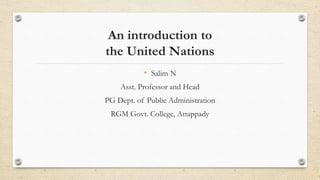The United Nations has four main purposes: maintaining international peace and security, developing friendly relations between nations, cooperating to solve international problems, and promoting respect for human rights. It is made up of over 30 affiliated organizations and provides a forum for countries to address global issues and balance national interests. While not a world government, the UN gives all member states, large and small, a voice to help resolve conflicts and formulate international policies on issues affecting humanity.




































